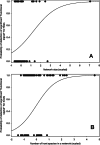Functional similarity affects similarity in partner composition in flea-mammal networks
- PMID: 38705882
- PMCID: PMC11070403
- DOI: 10.1007/s00436-024-08229-7
Functional similarity affects similarity in partner composition in flea-mammal networks
Abstract
Functional signal in an interaction network is a phenomenon in which species resembling each other in their traits interact with similar partners. We tested the functional signal concept in realm-specific and regional flea-host networks from four biogeographic realms and asked whether the species composition of (a) host spectra and (b) flea assemblages is similar between functionally similar flea and host species, respectively. Analogously to testing for phylogenetic signal, we applied Mantel tests to investigate the correlation between flea or host functional distances calculated from functional dendrograms and dissimilarities in sets of interacting partners. In all realm-specific networks, functionally similar fleas tended to exploit similar hosts often belonging to the same genus, whereas functionally similar hosts tended to harbour similar fleas, again often belonging to the same genus. The strength of realm-specific functional signals and the frequency of detecting a significant functional signal in the regional networks differed between realms. The frequency of detecting a significant functional signal in the regional networks correlated positively with the network size for fleas and with the number of hosts in a network for hosts. A functional signal in the regional networks was more frequently found for hosts than for fleas. We discuss the mechanisms behind the functional signal in both fleas and their hosts, relate geographic functional signal patterns to the historic biogeography of fleas and conclude that functional signals in the species composition of host spectra for fleas and of flea assemblages for hosts result from the interplay of evolutionary and ecological processes.
Keywords: Fleas; Functional dendrogram; Mammals; Mantel test; Traits.
© 2024. The Author(s).
Conflict of interest statement
Boris R. Krasnov is Subject Editor of Parasitology Research. Other authors declare that they have no competing interests.
Figures






References
-
- Amin OM, Wagner ME. Further notes on the function of pronotal combs in fleas (Siphonaptera) Ann Entomol Soc Amer. 1983;76:232–234. doi: 10.1093/aesa/76.2.232. - DOI
-
- Bartoń K (2023) MuMIn: multi-model inference. R package version 1.47.5. https://CRAN.R-project.org/package=MuMIn. Accessed Apr 2024
-
- Bates D, Mächler M, Bolker B, Walker S. Fitting linear mixed-effects models using lme4. J Stat Soft. 2015;67:1–48. doi: 10.18637/jss.v067.i01. - DOI
Publication types
MeSH terms
Grants and funding
LinkOut - more resources
Full Text Sources

